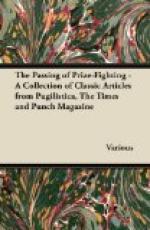[Illustration: FRESH EVERY DAY;]
for, we will defy any true gentleman to preserve an equanimity of expression under the hint—either visual or verbal—that (to use the language of the poet) you are “a man of brass.”
We have a faint recollection of a class of gentlemen who used to attach an heterogeneal collection of massive seals and keys to one end of a chain, and a small church-clock to the other. The chain then formed a pendulum in front of their small-clothes, and the dignified oscillation of the appendages was considered to distinguish the gentleman. They were also used as auxiliaries in argument; for whenever an hiatus occurred in the discussion, the speaker, by having resort to his watch-chain, could frequently confound his adversary by commencing a series of rapid gyrations. But the fashion has descended to merchants, lawyers, doctors, et sui generis, who never drive bargains, ruin debtors, kill patients, et cetera, without having recourse to this imposing decoration.
Rings are the next indicators of superfluous cash. As they are merely ornamental, they should resemble vipers, tapeworms, snakes, toads, monkey’s, death’s heads, and similar engaging and pleasing subjects. The more liberally the fingers are enriched, the greater the assurance that the hand is never employed in any useful labour, and is consequently only devoted to the minisitration of indulgences, and the exhibition of those elegant productions which distinguish the highly-civilised gentleman from the highly-tattooed savage.
Mourning-rings have an air of extreme respectability; for they are always suggestive of a legacy, and of the fact that you have been connected with somebody who was not buried at the expense of the parish.
Studs should be selected with the greatest possible care, and in our opinion the small gold ones can only be worn by a perfect gentleman; for whilst they perform their required office, they do not distract the attention from the quality and whiteness of your linen. Some that we have seen were evidently intended for cabinet pictures, rifle targets and breast-plates.
Pins.—These necessary adjuncts to the cravat of a gentleman have undergone a singular revolution during late years; but we confess we are admirers of the present fashion, for if it is desirable to indulge in an ornament, it is equally desirable that everybody should be gratified by the exhibition thereof. We presume that it is with this commendable feeling that pins’-heads (whose smallness in former days became a proverb) should now resemble the apex of a beadle’s staff; and, as though to make “assurance doubly sure,” a plurality is absolutely required for the decoration of a gentleman. In these times, when political partisanship is so exceedingly violent, why not make the pins indicative of the opinions of the wearer, as the waistcoat was in the days of Fox. We could suggest some very appropriate designs; for instance, the heads of Peel and Wakley, connected by a very slight link—Sibthorp and Peter Borthwick by a series of long-car rings—Muntz and D’Israeli cut out of very hard wood, and united by a hair-chain; and many others too numerous to mention.




